



 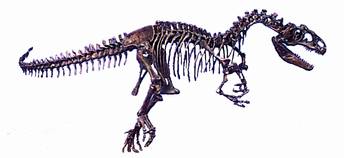 Vertebrates come in all shapes and sizes, which means that vertebrate fossils can be found in all shapes and sizes, and some have their own specific field of study. One such specific field is that of anthropology. It is this field that has experienced popularity and notoriety. Magazines and television programs, especially specialized educational channels, have contributed to making this such a popular field. Jane Goodall, along with Louis, Mary and Richard Leakey, are among those who have received notoriety through their appearances in magazines and on television. |
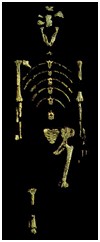 Australopithecus afarensis existed between 3.9 and 3.0 million years
ago. Afarensis had an ape like face with a low forehead, a bony ridge
over the eyes, a flat nose, and no chin. Afarensis also had protruding
jaws with large molar teeth. The cranial capacity varied from about
375 to 550 cc. Except for the more human like teeth, the skull is
similar to that of the chimpanzee. The canine teeth are much smaller
than those of modern apes, but larger and more pointed than those of humans,
and the shape of the jaw is between the rectangular shape of apes and the
parabolic shape of humans. However, their pelvis and leg bones more
closely resemble those of modern humans, leaving little doubt that they
were bipedal. Afarensis had a brain capacity that varying between
380 - 450 cc. Their bones show that they were very strong physically.
Heights varied between about 107 cm (3˝ feet) and 152 cm (5 feet).
Males and females show a considerable difference in size, varying from
1 - 1.7 m in height and from 25 - 50 kg in weight. This is a condition
known as sexual dimorphism, and in this case, females were substantially
smaller than males. The finger and toe bones are curved and proportionally
longer than in humans, but the hands are similar to humans in most other
aspects. Most scientists consider this as evidence that afarensis
was still partially adapted to climbing in trees, while others consider
it just an evolutionary remnant.
|
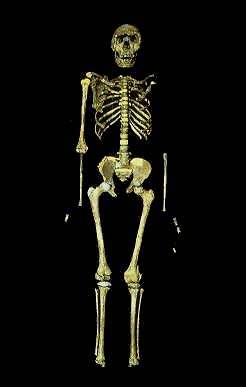 |
 |
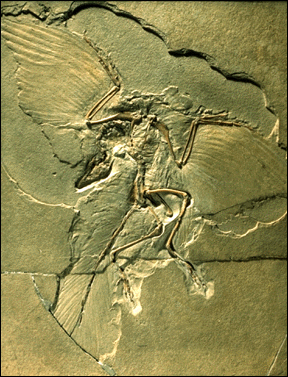 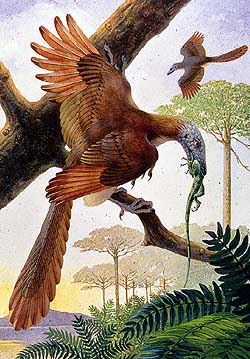 It has long been accepted that Archaeopteryx was a transitional form
between reptiles and birds. Lately, scientists have realized that
it even has more of a resemblance to its possible ancestors, the Maniraptora,
than to modern birds. Is Archaeopteryx an earlier ancestor to modern
birds and related to dinosaurs? The debate still continues, since
there have been no fossil discoveries to date showing evolutionary examples
between dinosaurs and Archaeopteryx. One study, based on the belief
that animals sharing a common ancestry exhibit common features during embryonic
formation, found a surprising result. If birds are related to dinosaurs,
there should be evidence in bird embryos of a thumb remnant, as dinosaurs
had such. However, in the microscopic examinations of the stages
of development in the embryos of birds, the embryos showed no vestige of
a thumb that is present in primitive form in dinosaur fossils. Yet
there are dinosaurs that had wishbones, three toed feet and cranial air
sacks, all distinctive bird-like features. It is now thought
that even pterosaurs had hollow bones, yet one more characteristic similar
to birds.
|
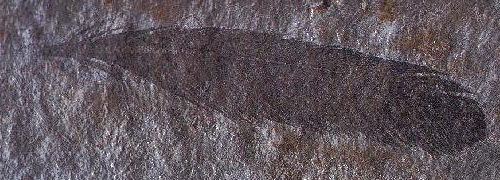  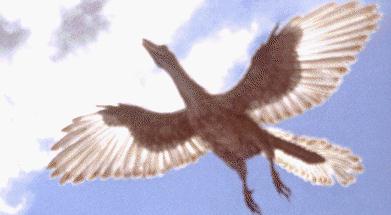  |
The origin of flight, and the actual flight capabilities of Archaeopteryx,
are still being debated as well. Archaeopteryx had a comparatively
flat sternum. Although it is currently thought that Archaeopteryx could
possibly fly, it was probably not a strong flier. It may well have ran,
leaped, glided, and flapped all in the same day. Is Archaeopteryx truly
a flying theropod? It shows virtually no avian characters not observed
in other theropods, with the large, distal, fully reversed hallux may be
the only exception. Is Archaeopteryx a theropod, and also a dromaeosaur,
because it shares a number of detailed characteristics only with dromaeosaur?
Some other characteristics are found only in the two forms and in some
basal birds. Could Archaeopteryx have been capable of flight like
the example of the modern bird above, or did it have to glide, as is thought
in one theory concerning pterosaurs? Click on the image of the pterosaur
above to see an example of how it might have been capable of flight.
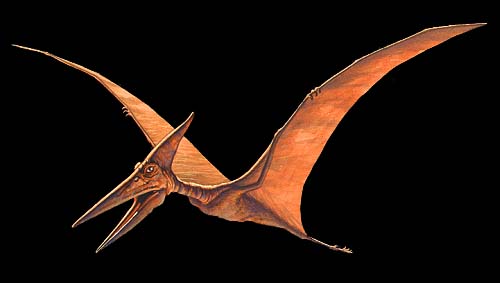 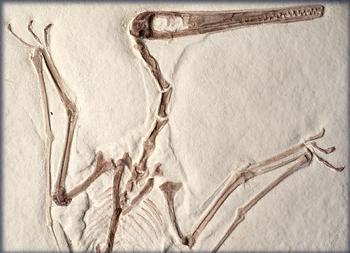  |
| Added to this debate are the pterosaurs mentioned above. The pterosaurs were a diverse group of flying reptiles found all over the earth during the reign of the dinosaurs. Pteranodon, shown in an image above, was a large pterosaur with a wingspan well over twenty feet. Pterosaurs were clearly thought to big and heavy to have the capability of flight but research is proving that pterosaurs had hollow bones, large brains with well developed optic lobes, and several crests on their bones to which flight muscles attached. All of this is consistent with powered, flapping flight. The most commonly known pterosaur, and a Hollywood favorite, is that of the Pterodactyl. It is seen in an image above. |
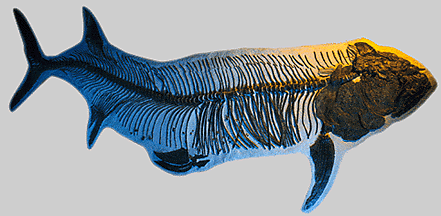 |
| To see what we have found so far in our own searches, just click
on the
image below. 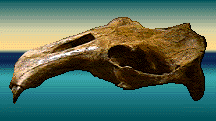 |
To see examples of what vertebrates were found during archaeological
excavations we have been present at, but with such examples not
necessarily fossils, click on the image below.
 |